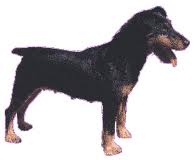The German Hunt Terrier, also known as the Jagd Terrier (”Jagd” is German for „hunt”) is the youngest hunting dog breed of German descent. Although it is first and foremost a working breed, typically used for hunting small game suchlike wild boars, fowl and rabbits above the ground, foxes and badgers underground and for trailing and retrieving quarry from land or water, this type of den terrier also makes an excellent companion. This breed is highly intelligent, highly adaptable to all surroundings, weather changes and all types of living conditions. Despite its strong prey drive, this breed is good-natured, even-tempered, quite friendly with people, though somewhat weary of strangers, and very affectionate and loyal to its family members. It makes a loving and gentle companion for children.

The German Hunt Terrier is a small-sized type of working terrier displaying all the qualities hunters appreciate endurance, sturdiness, fearlessness, flushing and retrieving abilities, excellent scent and vision and good controllability. Originally bred for year-round hunting purposes, the Jagd Terrier is becoming increasingly popular as a pet, suitable to be kept both indoors, in apartments (due to its small size) as well as outdoors, preferably in fenced courtyards, in order to prevent it from picking up a scent and wandering off in search of a trail. If kept in apartments, you should respect its daily need for exercise, because this is an active, energetic, alert and playful breed. Lack of regular exercise can have a negative impact on its overall health. Otherwise, this breed is hardy and does not suffer from any genetic disorders. Owners should check, however, for any signs of injuries at work, because it tends to take pain like a man and does not show any symptoms of being injured.
In terms of physical appearance, this breed is very robust, it has well-developed muscles, a well-proportioned head and the tail is typically cropped. As far as its coat is concerned, the Jagd Terrier comes in two varieties - wire-haired (with longer hair on its body and beard mandatory) and smooth-haired (the breed standard does not call for a beard). In both varieties, the hair is coarse and very dense, which makes it adaptable to any climate. The color of the coat is predominantly dark (black, dark brown, gray) with various shades of tan, yellow and red markings on the chest, legs and eyebrows. The breed standard requires the weight to be typically 16.5 (females) to 22 pounds (males) and the height at the withers 13 to 15.7 inches.
Due to being highly intelligent, training this breed can be fairly easy. Despite having an active, enthusiastic and outgoing temperament with acute hunting instincts, this breed is quite manageable and obedient indoors. When taking it for a walk or a run, because it needs plenty of regular activity, it is advised to keep it on a lead to prevent it from taking off suddenly and getting hit by a car. In terms of grooming, this breed is low maintenance, and due to its coarse hair, it requires no special trimming. It sheds moderately and requires baths occasionally.
The sturdy, fearless, exuberant yet docile German Hunt Terrier can be you hero and your loyal companion if you adopt it and, in addition, it can be an excellent and versatile working dog, used for hunting, flushing and retrieval of the quarry.




